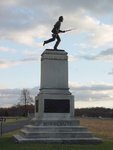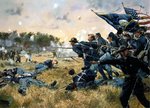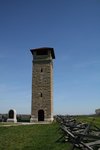syscom3
Pacific Historian
I was reading up on Gettysburg (During the war to fight Southern treachery) and found this written up about them.
During the charge, 215 members of the 262 men who were present at the time became casualties, including the regimental commander, Col. William Colvill, and all but three of his officers. ....... The 82 percent casualty rate stands to this day as the largest loss by any surviving military unit in American history during any single engagement.
Organization and early service
The 1st Minnesota was the first state volunteer regiment formally tendered to the Federal government under Abraham Lincoln's call for 300,000 troops in 1861, being offered on April 14 for three months service, Minnesota Governor Alexander Ramsey happening to be in Washington at the time. It was organized at Fort Snelling, Minnesota, on April 29 and subsequently remustered for three years service on May 10.
The regiment suffered significant losses during its term of service in the Eastern Theater. At the First Battle of Bull Run, it took the heaviest casualties of any Federal regiment on the field, an unfortunate honor that it would hold in more than one battle. At the Battle of Antietam, the Minnesotans and their parent brigade, commanded by the regiment's former colonel, Willis A. Gorman, were in General John Sedgwick's ill-famed assault on the West Woods, resulting in a Union rout from that part of the field. However, as always, the 1st Minnesota fought with courage and distinction.
Gettysburg
The men of the 1st Minnesota are most remembered for their actions on July 2, 1863, during the second day's fighting at Gettysburg, resulting in the prevention of a serious breach in the Union defensive line on Cemetery Ridge. Maj. Gen. Winfield S. Hancock, commander of the II Corps of the Army of the Potomac, ordered the regiment to assault a much larger enemy force (a brigade commanded by Brig. Gen. Cadmus M. Wilcox) in an effort to buy time while other forces could be brought up. During the charge, 215 members of the 262 men who were present at the time became casualties, including the regimental commander, Col. William Colvill, and all but three of his officers. The unit's flag fell five times and rose again each time. The 47 survivors rallied back to General Hancock under the senior surviving officer, Captain Henry C. Coates. The 82 percent casualty rate stands to this day as the largest loss by any surviving military unit in American history during any single engagement. The unit's flag is now in the Minnesota Capital's rotunda.
Despite the horrendous casualties the 1st Minnesota had incurred, it continued the fight the next day, helping to repulse Pickett's Charge. The surviving Minnesotans just happened to have been positioned at one of the few places where Union lines were breached during that engagement, and, as a result, charged the advancing Confederate positions one last time as a unit.
The monument to the 1st Minnesota at the Gettysburg National Battlefield Park bears the following inscription:
" On the afternoon of July 2, 1863 Sickles' Third Corps, having advanced from this line to the Emmitsburg Road, eight companies of the First Minnesota Regiment, numbering 262 men were sent to this place to support a battery upon Sickles repulse.
As his men were passing here in confused retreat, two Confederate brigades in pursuit were crossing the swale. To gain time to bring up the reserves save this position, Gen Hancock in person ordered the eight companies to charge the rapidly advancing enemy.
The order was instantly repeated by Col Wm Colvill. And the charge as instantly made down the slope at full speed through the concentrated fire of the two brigades breaking with the bayonet the enemy's front line as it was crossing the small brook in the low ground there the remnant of the eight companies, nearly surrounded by the enemy held its entire force at bay for a considerable time till it retired on the approach of the reserve the charge successfully accomplished its object. It saved this position probably the battlefield. The loss of the eight companies in the charge was 215 killed wounded. More than 83% percent. 47 men were still in line no man missing. In self sacrificing desperate valor this charge has no parallel in any war. Among the severely wounded were Col Wm Colvill, Lt Col Chas P Adams Maj Mark W. Downie. Among the killed Capt Joseph Periam, Capt Louis Muller Lt Waldo Farrar. The next day the regiment participated in repelling Pickett's charge losing 17 more men killed wounded."
During the chaotic fighting that took place in the repulse of Pickett's Charge, Private Marshall Sherman of Company C of the 1st Minnesota captured the colors of the 28th Virginia. Private Sherman received the Medal of Honor for his exploit. The flag was taken back to Minnesota as a prize of war and is displayed at the Minnesota Historical Society. In the mid-1990s, several groups of Virginians unsuccessfully sued the Society to return the 28th Virginia's battle flag to the Old Dominion State.



